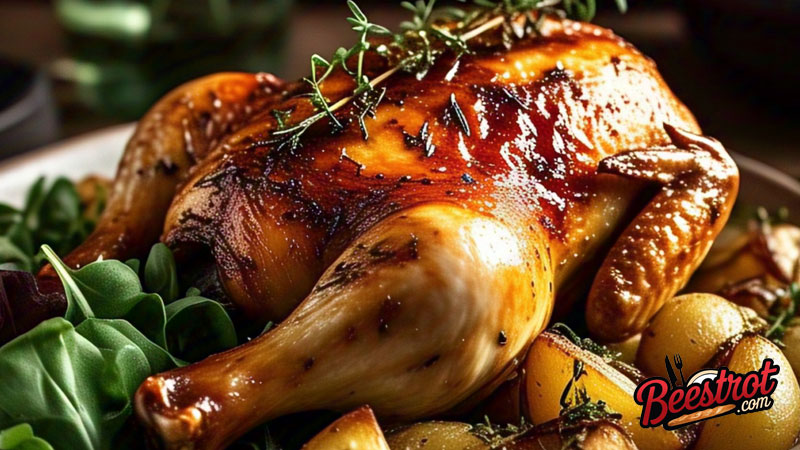Roast Chicken - Poulet Rôti

Click here to learn about our image policy and how to submit your own!
Roast chicken (Poulet Rôti) is a quintessential French dish that celebrates the art of simplicity and precision. This golden-brown roasted chicken, perfumed with herbs and garlic, became a Sunday tradition in households across France by the early 19th century. Each region developed their own variations, but the core technique of slow roasting to achieve crisp skin and succulent meat remains unchanged. The natural juices create a light, flavorful sauce that epitomizes French home cooking at its finest.
Time & Quantities
Method & Ingredients
Required Equipment: Roasting pan, kitchen twine, meat thermometer, basting brush, carving knife
Cooking Method: Roasting
Ingredients
- 1 whole chicken (about 4 lbs)
- 4 tbsp unsalted butter (softened)
- 4 garlic cloves (minced)
- 2 tbsp fresh thyme leaves
- 1 tbsp fresh rosemary (chopped)
- 1 lemon (halved)
- 1 small bunch fresh tarragon
- 1 tbsp olive oil
- 1 tsp salt
- 1/2 tsp black pepper
- 1 cup chicken stock
- 1/2 cup white wine
Instructions
- Preheat oven to 425°F (220°C).
- Remove giblets from chicken cavity and pat the chicken completely dry with paper towels - this is the secret to crispy skin!
- In a small bowl, mix softened butter with minced garlic, thyme, rosemary, salt, and pepper.
- Gently loosen the skin over the chicken breast and thighs, then spread half the herb butter underneath the skin.
- Rub the remaining herb butter all over the outside of the chicken.
- Season the cavity with additional salt and pepper, then stuff with lemon halves and tarragon.
- Truss the chicken by tying the legs together with kitchen twine.
- Place chicken breast-side up in a roasting pan and drizzle with olive oil.
- Roast for 30 minutes, then reduce temperature to 350°F (175°C).
- Continue roasting for about 60 minutes, or until a thermometer inserted into the thickest part of the thigh registers 165°F (74°C). Baste occasionally with pan juices - your kitchen will smell heavenly!
- Remove from oven and transfer chicken to a carving board. Let rest for 15 minutes - patience now means juicier meat later!
- Meanwhile, place roasting pan on stovetop over medium heat. Add stock and wine, scraping up browned bits. Simmer until reduced by half.
- Carve chicken and serve with the pan sauce.
Storage & Make-Ahead
Storage Advice: Refrigerate leftovers for up to 3 days.
Make-Ahead & Freezing Tips: The herb butter can be made a day ahead. Leftover chicken can be frozen for up to 2 months.
Nutritional & Dietary Information
Nutritional Information:
- Calories: 520
- Protein: 48g
- Fat: 32g (Saturated: 12g)
- Carbohydrates: 3g (Fiber: 0g, Sugar: 1g)
- Vitamin A: 10% DV
- Vitamin C: 5% DV
- Calcium: 4% DV
- Iron: 15% DV
Allergen Information: Contains dairy (butter)
Dietary Information: Contains dairy; not suitable for those with dairy allergies or vegans
Serving & Variations
Serving Suggestions: Place carved chicken pieces on a warmed platter with the breast in the center. Pour a small amount of sauce over the meat, serving the remainder on the side. Garnish with fresh herb sprigs. Best Side Dishes: Crispy roast potatoes, haricots verts (French green beans), or a simple green salad with Dijon vinaigrette.
Wine or Drink Pairing: A medium-bodied white Burgundy like Pouilly-Fuissé offers the perfect balance of richness and acidity. For something more accessible, try a Sonoma Chardonnay with moderate oak aging.
Possible Recipe Variations: Provençal version with herbes de Provence and black olives. Winter variation with root vegetables roasted alongside. Add a touch of lavender to the herb butter for a unique aromatic twist.
Additional Notes: Source high-quality, free-range chicken for best results.






Classic recipe that doesn’t require much effort, perfect for me! thanks!
This roast chicken looks good. I’ve never tried starting breast-side down before – interesting technique! Does it really help keep the white meat juicy?
This recipe is a standard roasting technique, you must be talking about “en crapaudine” flattened chicken which is different, it’s baked not roasted. I would say not much difference, what could make one though is baste the chicken with juice during cooking. Do it 3 to 4 times. Hope this help! 😊